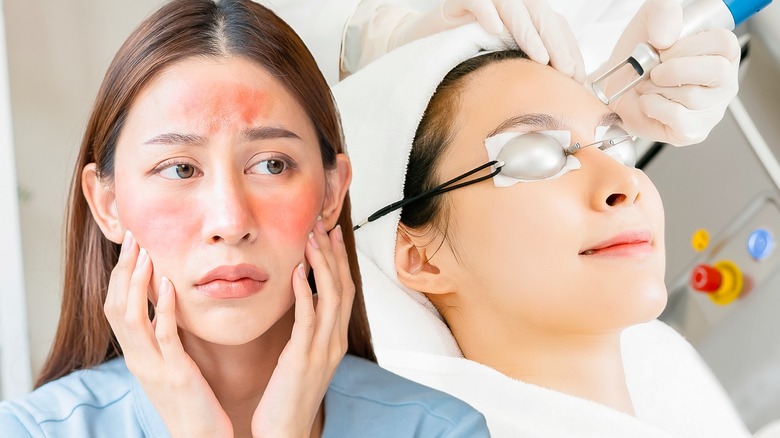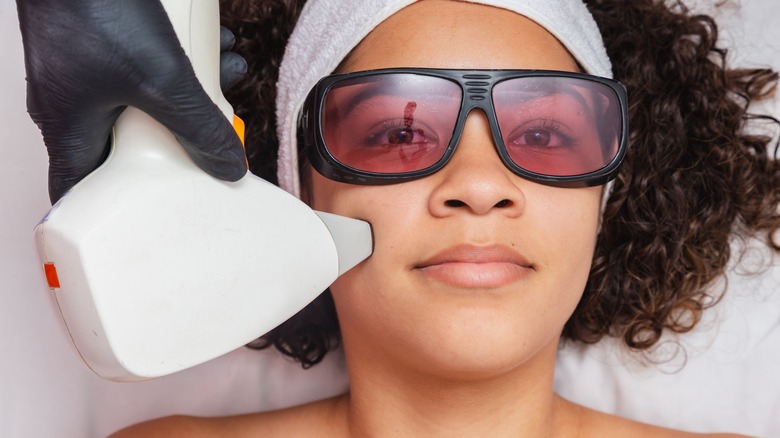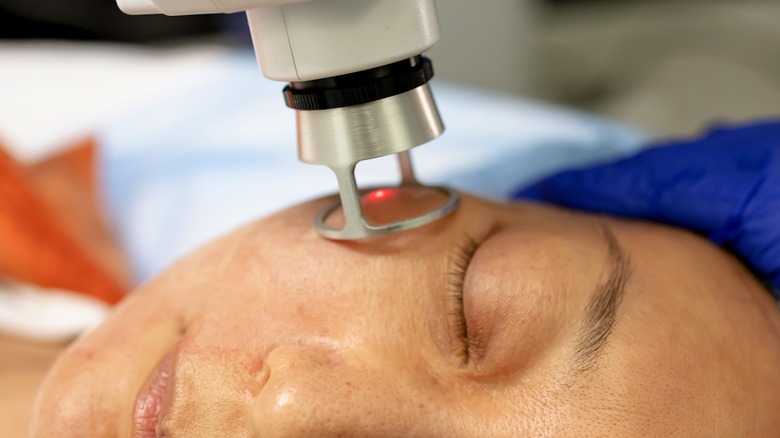A Dermatologist Tells Us What To Expect Going Into A Vbeam Treatment For Hyperpigmentation
Hyperpigmentation occurs when the skin overproduces melanin, a substance that leads to dark marks and an uneven skin tone, per the Cleveland Clinic. Common causes of dark spots include genetics, hormonal changes, sun damage, or acne scarring. There are many treatment options to address the different types of hyperpigmentation, including Candela Medical's Vbeam, a popular laser resurfacing system designed to target a number of skin conditions.
Glam spoke to board-certified dermatologist Dr. Aanand N. Geria, founder of Geria Dermatology, in an exclusive chat to shed some light on this advanced laser treatment. "Vbeam is a laser that emits concentrated, high-intensity light in short pulses," Dr. Geria explains to Glam. Vbeam laser also belongs to a specific category of laser devices known as pulsed dye lasers. "Pulsed dye lasers are used by dermatologists for non-invasive cosmetic and medical procedures, promoting smoother skin and reducing the appearance of vascular lesions," Dr. Geria expands.
In addition to helping you achieve smoother skin, Vbeam can also address a variety of other skin concerns. "It targets and treats vascular conditions like birthmarks, rosacea, and port-wine stains by focusing on the red pigment (hemoglobin) in blood vessels," Dr. Geria says. "The laser's energy is absorbed by the hemoglobin, causing the blood vessels to constrict and gradually fade." Vbeam can also be used to laser away acne scars, birthmarks, or melasma.
How does the Vbeam treatment work?
The two main types of laser rejuvenation include ablative and non-ablative lasers, according to Healthline, with Vbeam belonging to the latter. You don't have to worry about a lengthy healing process after a Vbeam session, as non-ablative lasers target smaller areas of the skin and will not cause severe peeling (via the American Society for Dermatologic Surgery). The highly targeted pulsed-dye technology also reduces discomfort and the number of sessions you need, with a typical course of treatment requiring two to four sessions. In turn, the reduced number of sessions helps decrease the overall cost of the treatment.
"The cost of Vbeam treatments can indeed fluctuate widely, depending on several factors that are unique to each patient," Dr. Aanand N. Geria explains exclusively to Glam. "The ultimate price tag is influenced by the area of the body being treated, the number of sessions necessary to achieve the desired results, and the geographical location of the dermatology practice." But just what do the numbers look like? According to Dr. Geria, the treatment's price "could range from $400 to $700 per session with at least three to four sessions required for optimal results."
Is this treatment right for you?
While pulsed dye lasers are considered safe for most skin types, it's best to consult a dermatologist prior to treatment to determine if Vbeam is a good fit for your skin and specific skin concerns. "Vbeam is safest [for] lighter skin tones," Dr. Aanand N. Geria shares exclusively with Glam. "Although it can be used on darker skin, extreme caution must be exercised due to the risk of post-inflammatory hyperpigmentation (dark spots) or hypopigmentation (light spots), which can lead to uneven skin tone. Darker skin tones are more prone to pigmentation changes after laser treatment."
In this case, the risk of post-inflammatory hyperpigmentation increases following laser treatment as individuals with medium-to-dark skin tones tend to produce higher amounts of melanin (via Healthline). Those with darker skin may also develop post-inflammatory hyperpigmentation, which results in white patches, per Medical News Today. Therefore, it's important to discuss with your dermatologist or certified laser technician to weigh the risks against the established benefits of undergoing a Vbeam treatment for hyperpigmentation.


